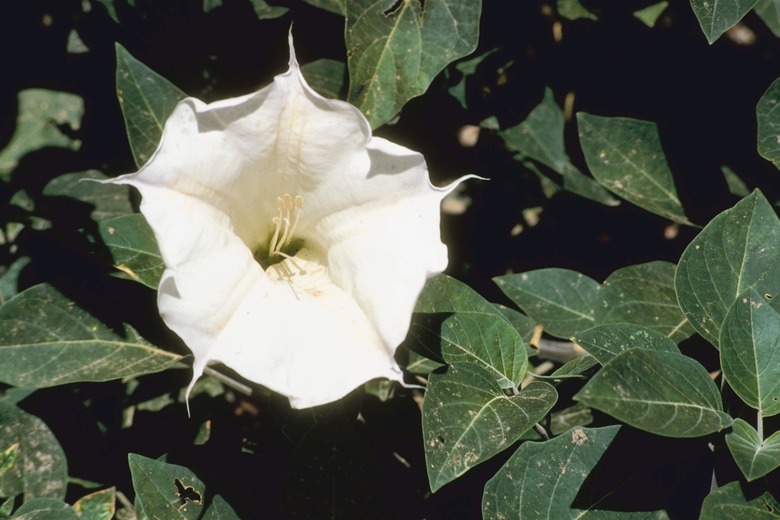What Weed Has A Round Prickly Seed Pod?
Step 1
Jimsonweed grows to heights of between 1 and 5 feet. Its leaves' edges are toothed edges and nearly egg shaped with pointed ends. Their length ranges from 2 to 8 inches. Funnel-shaped flowers are 2-1/2 to 4 inches long and open to a trumpetlike bell in white, violet or lavender. The plant's fruit is a spiny pod measuring roughly 2 inches in diameter. The seedpods grow as they ripen and the seeds mature. Ripe seedpods burst open, scattering the seeds.
Step 2
- Jimsonweed grows to heights of between 1 and 5 feet.
- Its leaves' edges are toothed edges and nearly egg shaped with pointed ends.
Datura Species
Step 1
Most species are low-growing, shrublike or spreading perennials or are prolifically reseeding annuals. D. wrightii is the species that is common to the Western United States. Rank-smelling leaves and large, white flowers that are occasionally tinged with purple characterize this plant. A sprawling perennial, the plants have enormous taproots that may extend deeper than 2 feet into the ground. Its geographic range extends from California to Utah, Arizona, New Mexico and into Texas. D. wrightii is considered a cosmopolitan annual weed that seeds prolifically. D. discolor is a native species found in riverbeds and desert washes in Arizona and southeastern California. It has smaller flowers. D, stramonium is naturalized throughout the United States. D. stramonium is distinguished from D. wrightii because the plants have smaller flowers and a more erect growing habit.
Step 2
- Most species are low-growing, shrublike or spreading perennials or are prolifically reseeding annuals.
- D. discolor is a native species found in riverbeds and desert washes in Arizona and southeastern California.
History
Step 1
The contraction of "Jamestown weed" is the origin of the name Jimsonweed. Soldiers and settlers were poisoned after eating the plant's leaves in salads. Long ago in India and Russia, robbers would grind up the seeds of Jimsonweed and mix them with water as a way to sedate, induce amnesia or daze people they intended to victimize and rob. Members of the ancient Indian religious order that worshipped Kali, the goddess of destruction, would also grind the seeds and feed them to people before robbing and/ murdering them. In China, Jimsonweed was prescribed for the sedative effects, for foot diseases and used for flatulence.
Toxic Effects
Step 1
All parts of Datura or Jimsonweed are poisonous. Keep places where livestock graze free of the plant. Ridding an area of plants is difficult and time consuming because of the ease with which seeds spread. Some people may experience skin irritation from contact with these plants, so wear protective clothing or gear. Symptoms of Jimsonweed poisoning include blurred vision, confusion, dilated pupils, dry mouth, difficulty urinating, hallucinations and tachycardia. Although it rarely causes death, later signs of toxicity may include coma and seizures. Emergency medical attention is necessary in cases of suspected Jimsonweed poisoning. Poisoning is treated with activated charcoal and gastric lavage. Severe sinus tachycardia is treated with beta-blockers.
Step 2
- The contraction of "Jamestown weed" is the origin of the name Jimsonweed.
- Members of the ancient Indian religious order that worshipped Kali, the goddess of destruction, would also grind the seeds and feed them to people before robbing and/ murdering them.
References
- Virginia Tech Weed Identification Guide: Jimsonweed: Datura Stramonium
- Plants That Make You Go Loco: Mind-Altering Plant Alkaloids: The Deadly Datura Called Jimsonweed; Wayne's World Volume 7 (Number 3) Fall 1998
- Cornell University; Plants Poisonous to Livestock; Datura spp.(Jimsonweed, Downy Thornapple, Devil's Trumpet, and Angel's Trumpet;) Jamie Jonker, 2008
